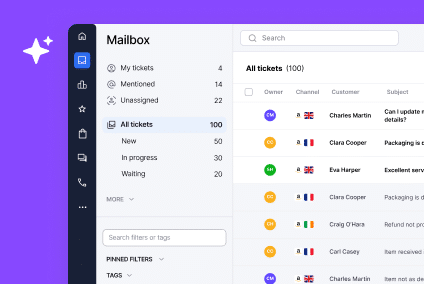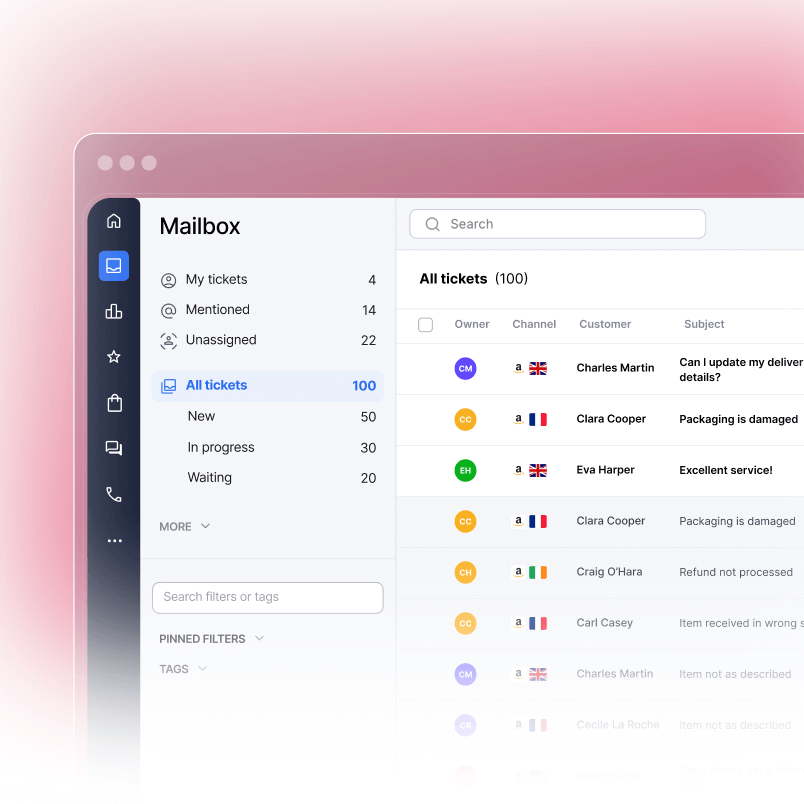How can proactive customer support reduce shopping cart abandonment? Most ecommerce teams focus on checkout optimization alone. But the missing piece is real-time support. When customers hit friction during checkout, they need immediate help, not a form or FAQ. This guide shows 12 tactics to deploy live chat, chatbots, and follow-ups that prevent abandonment before it happens.
What Is Shopping Cart Abandonment?
Shopping cart abandonment happens when a customer adds products to their cart but leaves without completing the purchase. It’s tracked as a rate: the percentage of created carts that don’t convert.
The global average cart abandonment rate is 70.19%. This means 7 out of 10 shoppers leave. The rates vary by device and industry. Mobile abandonment hits 77.65%. Luxury and jewelry see 81.68%. Groceries sit much lower at 50.03%.
The reasons shoppers abandon carts are usually addressable. Unexpected shipping costs lead 55% of shoppers to abandon. Complex checkout processes cause 22% to leave. Website errors account for 17% of abandonment. Each of these issues can be solved with timely, helpful support.
The financial impact is massive. Online retailers lose $18 billion in yearly revenue due to cart abandonment. Recoverable lost orders are worth $260 billion annually. The opportunity to recover lost sales is huge for any DTC brand or ecommerce team.
Why Customer Support Plays a Critical Role
Most abandonment recovery focuses on email. Send reminders, offer discounts, hope they return. But email is a broadcast channel. It doesn’t answer questions in real-time.
Proactive support solves this. When a customer hesitates at checkout, they often have a specific question: “What’s the shipping cost to Canada?” or “Do you have this in size 10?” Without immediate answers, they leave.
51% of people are more likely to keep buying from an online store that offers live chat support. Customers trust brands that talk back. Real-time support removes friction at the exact moment it matters.
Support builds trust during checkout. It shows you have humans behind the store. It turns a transactional experience into a conversation. And conversations convert better than static product pages. Using advanced CX software can help you deliver the seamless checkout experience your customers expect.
The best recovery strategy pairs both channels. Proactive support prevents abandonment in the first place. Email recovery catches what you missed. Together, they create a system that recovers sales at scale.
12 Proactive Support Tactics to Reduce Cart Abandonment
Tactic 1: Trigger live chat on the cart page
Deploy a chat widget that appears after 30-60 seconds on your cart page. The message should offer help: “Need help finishing your purchase? Chat with us now.”
Why it works: Customers on cart pages have intent. They’re close to buying. A friendly support prompt appears exactly when they need it. No guessing whether they want help.
Setup: Use tools like Gorgias or Tidio. Set location triggers for your cart page. Customize the greeting message.
Tactic 2: Offer FAQs through live chat
Train your chat system to answer common questions instantly. “What’s the shipping cost?” “Do you have this in blue?” “Can I return this?”
Why it works: 95% of chatbots can provide solutions in about 5 seconds. Customers get immediate answers without waiting for a human agent. This satisfies most simple questions and keeps serious issues for your team.
Setup: Build an FAQ knowledge base in your chat tool. Set up automation rules to route certain questions to pre-written answers.
Tactic 3: Deploy exit-intent chat offers
When a visitor’s cursor moves toward the back button or top of the page (exit behavior), trigger an offer in live chat. “Wait, use code STAY10 for 10% off your order.”
Why it works: Exit-intent triggers catch abandoners before they leave. The discount gives them a reason to reconsider. The personalized message from a real person is more persuasive than a generic popup.
Setup: Gorgias, Tidio, and similar tools support exit-intent triggers. Set a discount code. Test on desktop first, then mobile.
Tactic 4: Deploy FAQ chatbot on product and cart pages
Add a basic chatbot to your product description pages and cart page. This bot answers product-specific questions without human involvement.
Why it works: Customers often abandon because they lack information about products. A chatbot that proactively offers help (“Questions about this shirt? I can help!”) removes barriers before abandonment happens.
Setup: Use Tidio, Drift, or native Shopify chatbots. Train bots with FAQs specific to your products.
Tactic 5: Auto-offer incentives through chat
When a shopper hesitates or types a hesitation signal (like “too expensive”), trigger a chatbot offer. “How about 15% off if you complete today?”
Why it works: Timing matters. Offering a discount reactively, after the customer abandons, means you’ve already lost them. Offering it in the moment of hesitation lets them reconsider with real incentive.
Setup: Use Gorgias or Tidio to set up automation based on keywords or behavior triggers. Connect discount codes to chat messages.
Tactic 6: Send abandoned cart email with support link
Email recovery is powerful, but most emails just remind customers about their cart. Add a direct support link: “Have questions? Chat with our team here.”
Why it works: Abandoned cart emails achieve 39.07% open rate and 23.33% click rate. When you include a support link, you capture customers who click back because they need help, not just a reminder.
Setup: Add a “Chat with us” button or link in your abandoned cart email template. Route these clicks directly to live chat or a support page. For best practices on customer service automation, learn how to optimize your automated customer support workflows.
Tactic 7: Include live support badge in checkout
Add a small badge or banner to your checkout page that says “Chat with us” or “Questions? Get instant help.” Make it visible but not intrusive.
Why it works: Customers at checkout are uncertain. A support badge signals that help is available if they need it. The presence of support often reduces anxiety, even if they don’t use it.
Setup: Use your chat tool’s badge feature. Customize colors and text to match your brand. Place it in the bottom right or top right.
Tactic 8: Display return policy and shipping estimates in cart
Before checkout, show clear shipping costs and realistic delivery dates. Show your return policy prominently.
Why it works: 48% of shoppers abandon when they see unexpected fees during checkout. Transparency prevents sticker shock. When shipping costs are visible early, customers make informed decisions and stop abandoning.
Setup: Leverage Shopify, BigCommerce, or WooCommerce features to auto-display shipping estimates. Add a prominent return policy link in the cart page footer.
Tactic 9: Offer SMS support during checkout
Include an SMS option: “Prefer text? Text us at [number] for instant checkout help.”
Why it works: Some customers prefer SMS over chat. SMS has 50% average open rate, much higher than email. SMS feels personal and urgent.
Setup: Use a service like Gorgias that integrates SMS. Populate your checkout with SMS support options.
Tactic 10: Send SMS reminder with support CTA
Send an SMS 2-4 hours after cart abandonment (with customer consent): “You left items in your cart. Questions? Reply HELP or visit [link].”
Why it works: SMS reminders are more urgent than email. Adding a support call-to-action gives abandoners a way to get help before deciding to leave for good.
Setup: Use Klaviyo, Gorgias, or similar platforms. Set SMS to trigger based on cart abandonment after 2-4 hours.
Tactic 11: Create a dedicated checkout support flow
Train your support team to prioritize checkout questions. When a customer asks a question during checkout, reply within 2 minutes with the answer.
Why it works: Speed matters. Customers at checkout are ready to buy. A 2-minute response keeps momentum. A 2-hour response loses them.
Setup: Create a Slack or internal notification system for checkout questions. Prioritize these over other support tickets. Set team SLAs for checkout responses.
Tactic 12: Segment high-value carts for VIP support
For orders over a certain value (e.g., $500+), route abandonment to a VIP support agent instead of general recovery.
Why it works: High-value customers need more attention. A personalized email or call from a dedicated agent recovers more high-value carts than generic automation.
Setup: Use your CRM or helpdesk to segment by cart value. Route VIP abandonment to specific team members. Personalize outreach.
Support Tools That Enable These Tactics
Gorgias
Gorgias offers cart page triggers, macros, and automation. You can set live chat to appear on cart after X seconds. Automation templates let you offer discounts or send follow-ups based on customer behavior.
Best for: Shopify stores and multi-channel support.
Features: Live chat, email, SMS integration, cart triggers, automation.
Tidio
Tidio provides a chatbot builder and live chat on a single platform. Exit-intent triggers and pre-written responses make setup fast.
Best for: Quick chatbot deployment without technical setup.
Features: Chatbot, live chat, automation, exit-intent triggers.
Re:amaze
Re:amaze combines live chat with a comprehensive FAQ system. You can create a knowledge base and trigger specific FAQ sections based on customer behavior.
Best for: Brands that want FAQ automation plus live chat backup.
Features: Live chat, FAQ automation, customer messaging.
Klaviyo
Klaviyo specializes in abandoned cart email flows. Set up multi-email sequences that trigger automatically. Add dynamic content to show the exact cart items.
Best for: Email automation and segmentation.
Features: Abandoned cart flows, SMS, dynamic content, segmentation.
Zendesk
Zendesk is enterprise-grade support software. Deploy chat, ticket systems, and automation across all channels.
Best for: Large teams with complex support needs.
Features: Live chat, tickets, knowledge base, automation, multi-channel.
| Tool | Best Feature for Cart Recovery | Best For | Platform |
| Gorgias | Cart page triggers and automation | Shopify sellers | Shopify, WooCommerce, BigCommerce |
| Tidio | Exit-intent chatbot | Small to mid teams | All platforms |
| Re:amaze | FAQ automation | Multi-channel sellers | All platforms |
| Klaviyo | Email sequences and SMS | Email automation | All platforms |
| Zendesk | Enterprise automation | Large teams | All platforms |
How to Measure Success
Track these metrics to understand if your proactive support is working:
Chat conversion rate
Divide customers who chat during checkout by customers who complete purchase. Compare to your overall conversion rate. If chat reduces abandonment, this rate should exceed your baseline.
Track: Weekly in your chat tool’s analytics dashboard.
Abandoned cart recovery rate
Divide recovered carts by total abandoned carts. A respectable recovery rate falls between 10-15%. Top performers hit 20%+.
Track: Monthly in your email and SMS platforms (Klaviyo, Gorgias).
Chat engagement rate
Divide chat interactions by unique cart visitors. Higher engagement means more customers are using support.
Track: Weekly. Target 5-15% engagement.
Email open and click rates
Abandoned cart emails average 40-50% open rate and 20-25% click rate. If your rates are lower, test subject lines and timing.
Track: Daily in Klaviyo or similar platform.
Revenue recovered
Running three abandoned cart emails generates $24.9 million in revenue compared to $3.8 million from single emails. Campaigns using multiple emails outperform single-email sequences.
Calculate: Total revenue from recovered carts / Total abandonment value.
A/B test results
Run a test: week one without proactive chat, week two with proactive chat. Compare abandonment rates. This proves impact.
Example: Week 1 (no chat) = 72% abandonment. Week 2 (with chat) = 68% abandonment. That’s a 4% improvement, or 4 carts recovered per 100 created.
FAQs
What’s the average shopping cart abandonment rate?
The global average is 70.19% across all industries. Mobile abandonment is higher at 77.65%. Luxury goods see 81.68%. Groceries are much lower at 50.03%.
Does live chat actually reduce cart abandonment?
Yes. 51% of people are more likely to keep buying from stores with live chat support. Additionally, 85% of online conversations are now handled by chatbots, which reduce response time and improve first-contact resolution.
What’s the best tool for abandoned cart recovery?
It depends on your platform and budget. Gorgias is best for Shopify. Klaviyo excels at email sequences. Tidio is fastest to deploy. Most successful brands use a combination: live chat during checkout (Gorgias or Tidio) plus email recovery (Klaviyo).
Should I offer a discount when someone abandons their cart?
Discounts help, but only if timing and relevance are right. Personalized recovery emails boost recovered revenue by 5-10%. Use discounts strategically for high-value carts or repeat abandoners, not everyone.
What’s the best time to send an abandoned cart email?
Send the first email within 1-2 hours of abandonment. Send a second email 24 hours later. Send a third (optional) email 72 hours later with a stronger incentive. Sending three emails recovers more sales than one email.
What’s the ROI of abandoned cart recovery?
Abandoned cart emails deliver $5.81 in revenue per recipient. Campaigns with three emails generate $24.9 million versus $3.8 million from single emails. For most brands, recovery campaigns offer 3-5x ROI.
How many agents do I need for proactive cart support?
This depends on your traffic. If you get 1,000 visitors per day, one part-time agent can handle checkout questions. If you get 50,000+ visitors daily, you need a dedicated team or heavy chatbot automation. Start with one agent monitoring checkout questions during peak hours, then scale based on chat volume.




